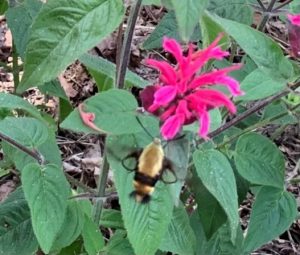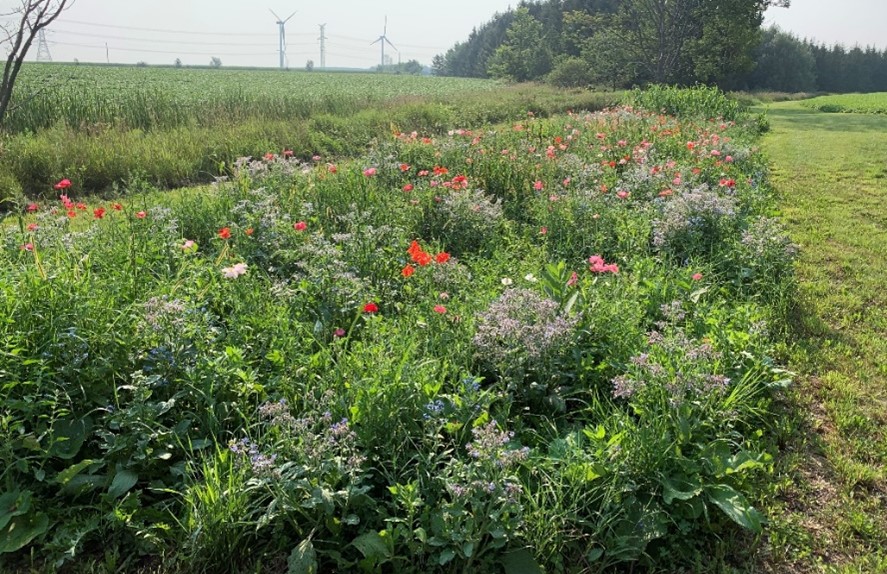Allison Stoecker has been operating a 2,000-acre cash crop farm with her husband since 1992. The operation rotates through corn, wheat, soybeans, and white beans. They have undertaken many tree plantings on the farm over the years, but recently Allison has found a new purpose to focus on planting native species.

Allison Stoecker preparing buffer area for planting. Photo by Jess Stoecker.
Allison studied horticulture but it was only about four years ago that the priority of planting native species took hold. She came across the importance of planting native species because of a personal goal. “I wanted to bring more biodiversity to my yard,” she explains. “I wanted to put in a pond and just have more wildlife areas and bring more birds in and then I realized, ‘Oh, that’s what you have to do’.”
Allison has undertaken many projects on her farm over the years. She has planted trees, shrubs, and flowers around her house and field edges. Sometimes these plantings involved retiring and reforesting small corners of fields that were awkward to farm. She has even done plantings on her children’s properties.
In the past 2 years with Maitland Conservation, Allison has planted native species buffers along the drains on her properties. She aims for these plantings to provide benefits of erosion control, windbreaking, and improved water quality, as well as biodiversity and pollinator support. She has also enlisted the help of family to remove buckthorn on one property, with the intention of reforesting the gaps with native tree species.
In addition to trees and shrubs, Allison has added a pollinator-supporting wildflower plot to her restoration actions. “It was just this big grassy area, and we were just always kind of keeping it mowed … But I took a chunk of that and planted a big wildflower meadow,” she explains.
Allison impressively takes most of these planting projects on herself but does get some help from her daughters when they are home. Her husband has also stepped in with the post-hole digger to help with larger trees and he has even designed a watering system. “[He] built me this really great water tank that I pull behind my [tractor] and I can just go out there and keep them watered for the first year or two,” Allison describes.
Undertaking these plantings does come with some challenges. For example, the trees by the drain make it difficult to side-cut, so grass and weeds often grow over the seedlings. To manage this issue, Allison stakes the seedlings and protects them with cages so that they are easier to find and less likely to be overgrown. Additional techniques that Maitland Conservation recommends to control competing vegetation are mowing, mulching, placing coco mats at the bases of trees, and strategically applying herbicides.
It can also be disheartening when some of the trees don’t survive, especially after the winter. But Allison is determined to infill the gaps. “I’m just going to go keep plugging more trees in there,” she says.
Another challenge that affects survival rate is the crop growing season, as it limits her access and ability to care for the trees. “Sometimes I have to wait for a crop to come off before I can go back and check them or water them, and the ones that are farther away I don’t always get to as often,” says Allison. Developing a planting access plan before crops are too high can help manage this issue.
Allison asserts that these challenges are worth the benefits. The plantings add wildlife and natural beauty to her property and bring joy to her dog walks. She also appreciates how the drain buffer plantings add shelter and a resting place for birds. Allison expresses that the plantings make her feel hopeful for the future, “just to imagine these trees getting bigger and providing more shade and providing more shelter.”
Allison’s advice for those considering planting is pragmatic: “Get started now.” She continues, “And then plant the right trees. Get the native trees and the native shrubs so that you’re providing as much benefit as possible… You’re doing so much for the environment, and you get so much out of it, and so

Scarlet bee balm. Photo by Allison Stoecker.
much is gained. So do it, just plant trees and get started.”
Ultimately, planting native species has amplified Allison’s love for horticulture. “This is what I can do to help biodiversity and help wildlife and plant more trees,” She enthuses. “I [have] a renewed purpose and mission.”
If you would like to do a planting project like one of Allison’s, Maitland Conservation has up to 100% funding available for streamside buffer projects in the watershed, including trees and shrubs, as well as native wildflower and grassland plantings. If you would like to learn more about project options for your property and how to get started, check out our page on New Grants for Stream Buffer Projects or contact our staff.
Greg Urquhart
Forestry Technician
[email protected]519-335-3557 ext. 235
Shannon Millar
Restoration Technician
[email protected]
519-335-3557 ext. 233

Allison Stoecker’s pollinator plot. Photo by Allison Stoecker.
